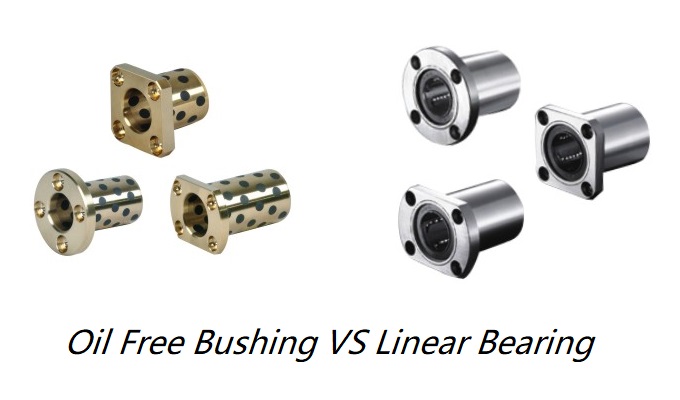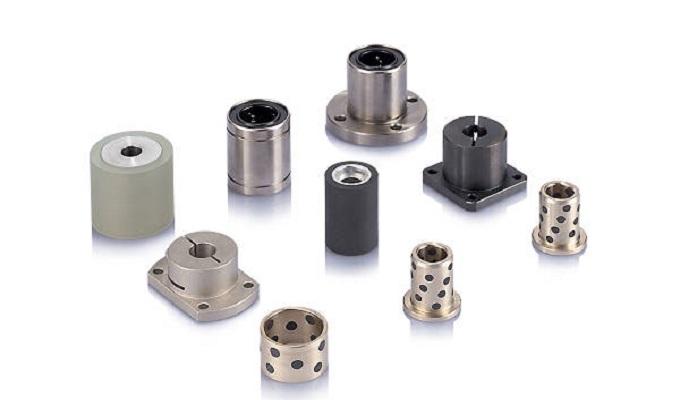Oil-free bushings and linear bearings are essential mechanical components, each possessing unique characteristics and application advantages. However, when selecting the appropriate bearing type, a thorough understanding of their construction, performance, and suitable scenarios is required. This article aims to compare oil-free bushings and linear bearings, aiming to uncover their similarities and differences, as well as the pros and cons in real-world applications.
What is an Oil-Free Bushing?
An oil-free bushing is a mechanical component designed for smooth linear motion within systems. Constructed from a high-quality low-carbon steel base, it features a sintered layer of spherical porous copper powder in the middle, coated with a wear-resistant lubricating material primarily composed of PTFE (polytetrafluoroethylene) on the surface. This combination serves as the bearing working layer. This material exhibits exceptional mechanical load-bearing capabilities. The copper powder layer aids in dissipating the heat generated during operation while enhancing the bond strength between the plastic layer and the substrate. The PTFE design is suitable for dry friction conditions, and a variety of materials have been developed based on lubrication requirements, friction coefficients, and durability needs.
When paired with a guiding shaft, both linear bearings and oil-free bushings can be utilized. In gear shift mechanisms, linear bearings are often preferred due to their lower friction resistance and superior tactile feel. Despite having a lower load-bearing capacity and a higher cost, linear bearings offer advantages in terms of reduced friction and enhanced sensitivity. On the other hand, oil-free bushings employ sliding friction, resulting in higher resistance and a less refined feel, yet they are capable of bearing larger loads and are more cost-effective.
What is a Linear Bearing?
A linear bearing is an essential component utilized within linear motion systems to achieve straight-line travel. Typically employed in conjunction with cylindrical shafts, linear bearings facilitate precise linear movement. Within a linear bearing, steel balls make point contact with the bearing sleeve, allowing these balls to roll with minimal friction resistance. As a result, linear bearings exhibit characteristics of low friction, relative stability, and independence from bearing speed, enabling high sensitivity and precision in smooth linear motion.
Internally equipped with steel balls for rolling friction, linear bearings exhibit reduced resistance and excellent tactile feedback. However, they tend to have a relatively lower load-carrying capacity and come at a higher cost. Despite these limitations, linear bearings are commonly preferred in foreign automobile applications.
In scenarios involving guide shafts, both linear bearings and oil-free bushings can be viable choices. Linear bearings are often favored for gear shift mechanisms due to their low friction resistance and superior tactile sensation. Despite their lower load capacity and higher cost, their advantages lie in reduced friction and heightened sensitivity. Conversely, oil-free bushings employ sliding friction, resulting in higher resistance and a coarser feel, but they excel in bearing larger loads at a more budget-friendly price point.
The Common of Oil Free Bushing and Linear Bearing
Compatibility with Guide Shafts: Both oil-free bushings and linear bearings can be used in conjunction with guide shafts to facilitate linear motion.
Linear Motion: Both components are designed to enable straight-line motion within mechanical systems.
Variability in Friction Mechanism: While oil-free bushings primarily rely on sliding friction, some variations also utilize ball bushings for rolling friction. Linear bearings, on the other hand, achieve sliding through the rolling of steel balls.
Differences Between Oil-Free Bushings and Linear Bearings
Precision and Friction Coefficient: Linear bearings offer high precision and low friction coefficients, making them suitable for scenarios with light loads and high-speed movement. However, they may have lower vibration resistance and come at a higher cost. Oil-free bushings can achieve similar precision requirements, but they have higher friction coefficients and greater resistance. They are better suited for heavy loads, harsh environmental conditions, and low-speed movement, often at a lower cost.
Resistance and Load Capacity: Bushings tend to exhibit higher resistance during operation but possess greater load-carrying capacity and lower tactile feel. Linear bearings, due to their internal steel ball design, offer reduced running resistance, better tactile feedback, but relatively lower load-carrying capacity.
Application Scenarios: Oil-free bushings are versatile for both linear and rotational motion, whereas linear bearings are primarily intended for linear motion. However, there are also ball-bearing linear guides suitable for combined linear and rotational movements.
Cost: Linear bearings generally come at a higher cost compared to oil-free bushings.

Features of Oil-Free Bushings
1) Utilizes sliding friction, resulting in higher friction coefficients and subsequently greater resistance.
2) Precision is generally slightly lower than that of linear bearings, but appropriate measures can still achieve comparable levels of accuracy.
3) Suited for heavy loads and harsh environments. For instance, many heavy machinery applications, such as die-casting machines, utilize oil-free bushings to withstand challenging conditions like high temperatures, low temperatures, dust, and oil contamination.
4) Demonstrates robust vibration resistance, making it suitable for low-speed heavy-load movements.
5) Applicable to both linear and rotational motion.
6) Durable and requires less frequent maintenance.
7) Slim profile, occupying less space.
8) Relatively lower in price, providing a cost advantage.
Features of Linear Bearings
1) Generally higher precision, utilizing rolling friction with lower friction coefficients, leading to reduced friction force during sliding and lower resistance.
2) Less resilient to vibrations, suitable for high-speed light-load scenarios but still capable in low-speed situations.
3) Requires a cleaner environment, tends to be relatively more expensive, and adverse conditions might impact performance.
4) Primarily designed for linear motion, but ball-bearing linear guides are available for combined linear and rotational scenarios.
5) Relatively higher in price.
In cases where equipment demands non-standard assembly, features like better environmental conditions, higher precision, and lighter loads often lean towards choosing linear bearings. For example, small roller presses or bearing presses typically opt for linear bearings as guiding components.
Choosing Between Oil-Free Bushings and Linear Bearings
When selecting between oil-free bushings and linear bearings, it's essential to consider their construction, performance characteristics, and cost differences. However, the most crucial factor is to align the decision with specific operational requirements. Different applications have diverse demands for bearings, making it vital to choose the product that best suits the practical needs of the system. Comprehensive assessment of these factors is essential for achieving optimal performance and efficiency.







